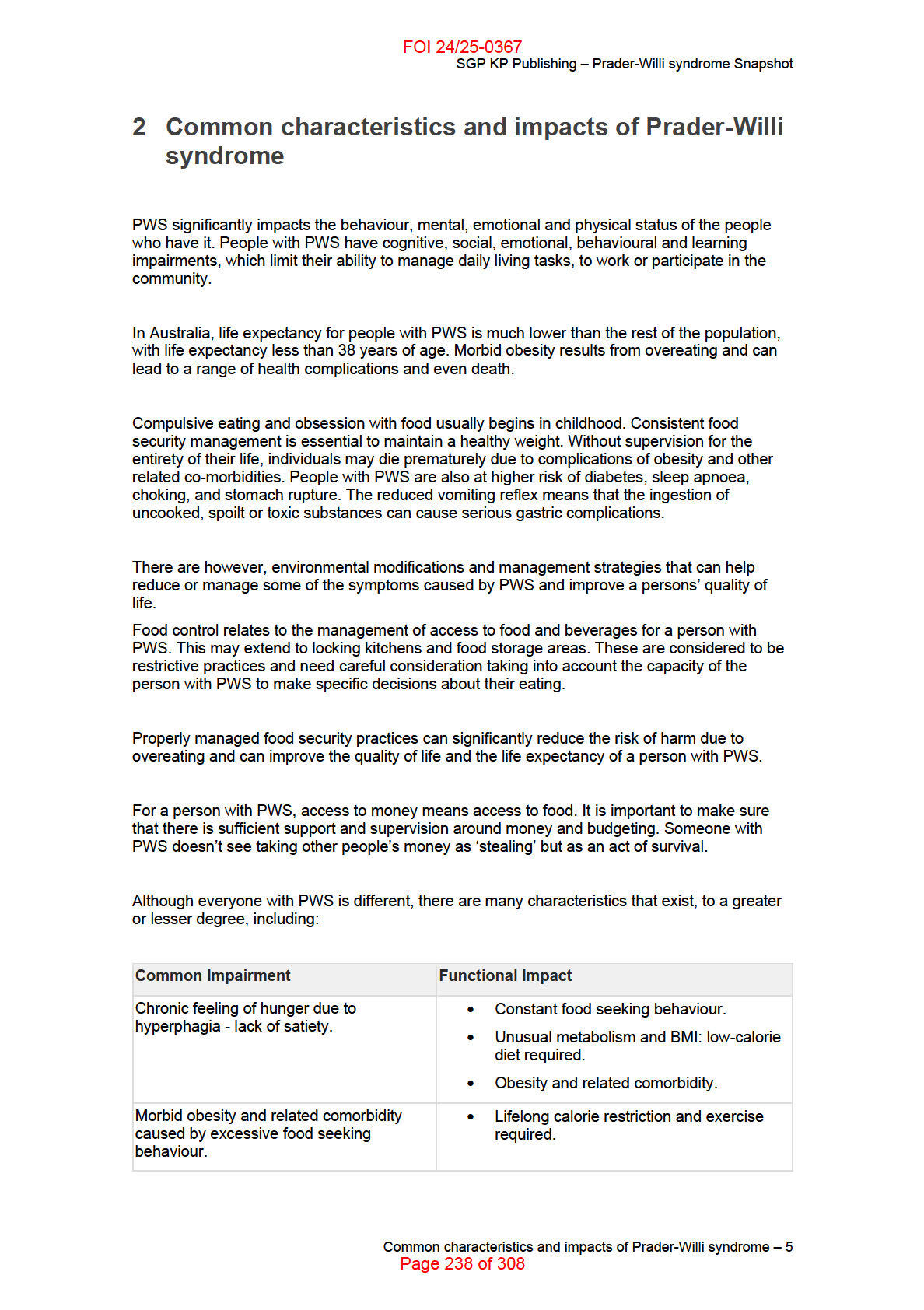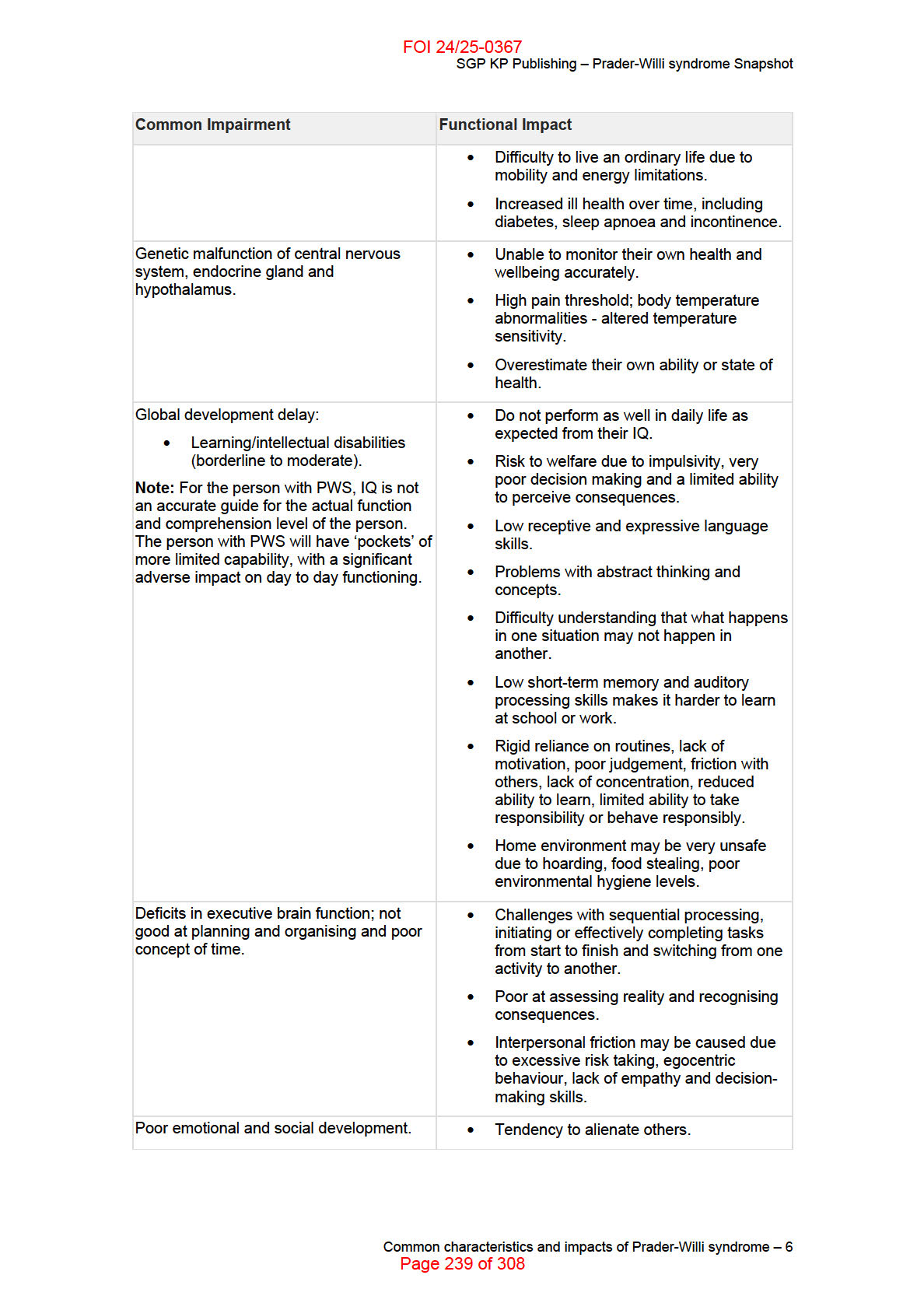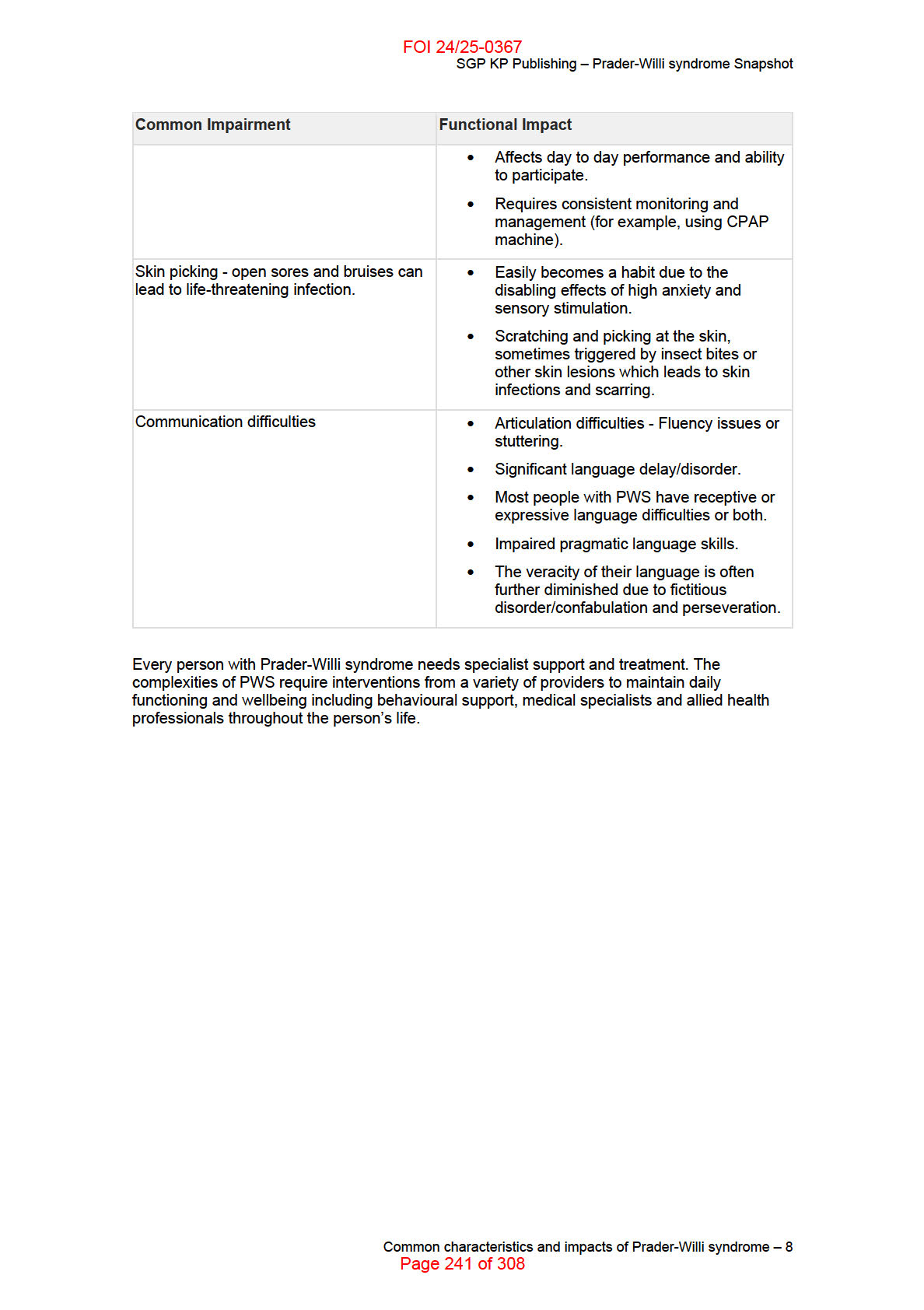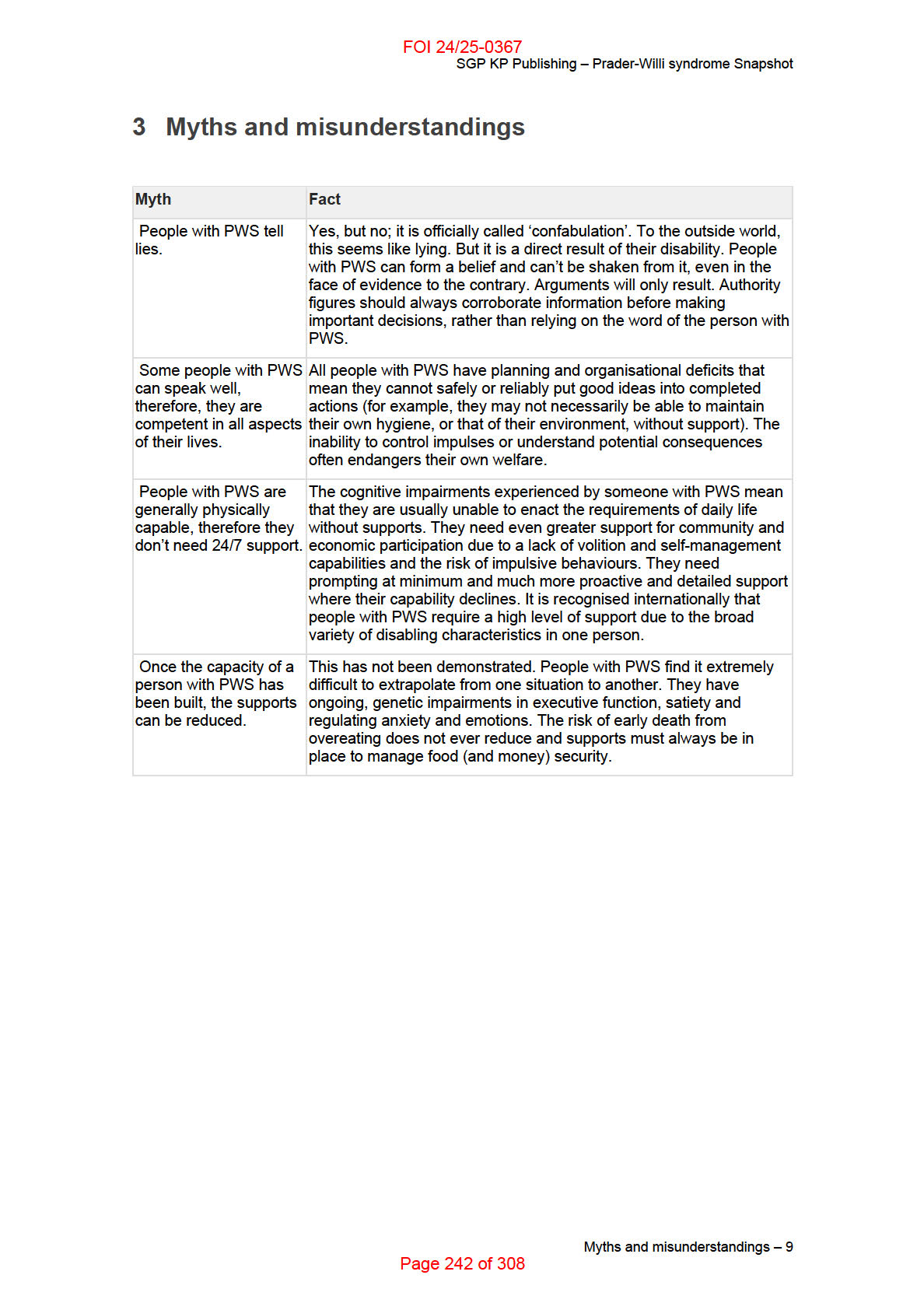FOI 24/25-0367 - DISCLOSURE LOG - DOCUMENTS
DOCUMENT 19
Prader-Willi syndrome Snapshot
SGP KP Publishing
Exported on 2024-10-18 03:13:47
Page 234 of 308
FOI 24/25-0367 - DISCLOSURE LOG - DOCUMENTS
SGP KP Publishing – Prader-Wil i syndrome Snapshot
Table of Contents
1 What is Prader-Wil i syndrome? . . . . . . . . . . . . . . . . . . . . . . . . . . . . . . . . . . . . . . . . . . . . . 4
2 Common characteristics and impacts of Prader-Wil i syndrome . . . . . . . . . . . . . . . . . . 5
3 Myths and misunderstandings . . . . . . . . . . . . . . . . . . . . . . . . . . . . . . . . . . . . . . . . . . . . . . 9
4 Common barriers to social and economic participation . . . . . . . . . . . . . . . . . . . . . . . . 10
5 What is the role of the family in providing support? . . . . . . . . . . . . . . . . . . . . . . . . . . . 11
6 How can I tailor a meeting to suit a person with PWS? . . . . . . . . . . . . . . . . . . . . . . . . . 12
7 Helpful links for further information . . . . . . . . . . . . . . . . . . . . . . . . . . . . . . . . . . . . . . . . 14
8 Representative bodies consulted when developing this Snapshot . . . . . . . . . . . . . . . 15
Table of Contents – 2
Page 235 of 308
FOI 24/25-0367 - DISCLOSURE LOG - DOCUMENTS
SGP KP Publishing – Prader-Wil i syndrome Snapshot
This is a snapshot and is not designed to be a comprehensive guide. It provides general
information about Prader-Wil i syndrome (PWS) for NDIA staff and Partners. It is not to be
distributed externally.
Each person with PWS is an individual but there is a commonality of impairment. Beyond that,
each has their own additional needs, preferences and experiences that wil impact on the
planning process.
In developing this resource, we consulted with Prader-Willi Syndrome Australia.
What is Prader-Wil i syndrome? – 3
Page 236 of 308
FOI 24/25-0367 - DISCLOSURE LOG - DOCUMENTS
SGP KP Publishing – Prader-Wil i syndrome Snapshot
1 What is Prader-Willi syndrome?
Prader-Wil i syndrome (PWS) is a rare neuro-behavioural genetic disorder. It is a very complex,
multistage disorder that permanently affects multiple systems in the body. PWS presents at
birth and continues, with significant intensity, throughout life. It occurs equally in males and
females.
People with PWS have a flaw in the part of the brain called the hypothalamus. This part of the
brain is an important supervisory centre and hormone regulator. The hypothalamus when fully
functioning, registers feelings of hunger and satiety (fullness). For individuals with PWS this
does not occur and individuals with PWS never feel full. There is a constant pre-occupation with
food accompanied by an overwhelming physiological drive to eat.
Currently there is no cure for PWS, although advances are being made through treatment with
Growth Hormone. Most people with PWS require specialist support and a supervised diet for
life. Generally, PWS is not inherited (except in 5% of cases) and can occur in any family. A
suspected diagnosis of PWS is usually made by a physician based on clinical symptoms and a
genetic test confirms a diagnosis of PWS. It is estimated that the incidence of PWS varies from
1:15,000 to 1:25,000 births.
What is Prader-Wil i syndrome? – 4
Page 237 of 308





FOI 24/25-0367 - DISCLOSURE LOG - DOCUMENTS
SGP KP Publishing – Prader-Wil i syndrome Snapshot
4 Common barriers to social and economic
participation
People with PWS have the same aspirations as everyone else; to be in a loving relationship, to
have friends, to participate in community life and work and to feel included as full citizens.
However, like many people with disability, people with PWS encounter multiple barriers to
social, economic and civic participation. These barriers include discriminatory attitudes,
perceptions and misconceptions as well as environmental and social barriers.
• Community attitudes
o Lack of community awareness and understanding about the complexities of
PWS resulting in stigma and exclusion.
• Difficulty accessing services in the mainstream community
o Limited community resources and venues to support people with PWS to be
included in the community such as sporting clubs and public spaces.
o Reluctance on the part of organisations and facility staff to seek training and
explore ways to support people with PWS who want to access mainstream
activities and facilities.
o Inadequate access to mental health services where there has been a tendency
to attribute difficult behaviour to the intellectual disability, rather than an
emerging mental il ness.
• Education
o Reluctance on the part of schools to fund professional development, PWS
training and explore ways to support people with PWS so they can access and
participate in the full school curriculum.
• Difficulty accessing and maintaining employment.
• Housing
o Lack of housing options that provide safe and supported accommodation that
meets the specific needs of the person with PWS including substantive support,
food security and adequate staffing capabilities.
• Transport
o Lack of flexible transport arrangements and supports to allow management of
unsupervised access to food and challenging behaviours.
o While people with PWS are able to physically use public transport, it may not
be an option all the time, for reasons of safety for the person with PWS and
those around them.
Common barriers to social and economic participation – 10
Page 243 of 308
FOI 24/25-0367 - DISCLOSURE LOG - DOCUMENTS
SGP KP Publishing – Prader-Wil i syndrome Snapshot
5 What is the role of the family in providing support?
Families provide different levels of support to the person with PWS depending on the individual
family circumstances. Usually they play an active role in the areas of management of food
security, dietary and exercise management, supporting daily living tasks, medical care, money
management and advocating on their behalf. This is often beyond the age that you would
generally expect a parent or family member to provide support.
Parents of children with PWS consistently report higher levels of stress than families of other
complex disabilities and have higher incidence of family relationship problems. This is often due
to the 24/7 vigilance required to manage the hyperphagia and other behavioural problems such
as aggression.
Even if the person with PWS transitions to supported accommodation the family often chooses
to remain involved to advocate for their family member. Where possible, families may choose to
also have a role in attending medical and allied health appointments. But due to the extensive
list of medical and allied health appointments, parents and family members may find this difficult
to manage.
Consideration should be given to a holistic approach when reviewing informal supports to
maintain sustainability and to safeguard against disintegration of the family unit.
What is the role of the family in providing support? – 11
Page 244 of 308
FOI 24/25-0367 - DISCLOSURE LOG - DOCUMENTS
SGP KP Publishing – Prader-Wil i syndrome Snapshot
6 How can I tailor a meeting to suit a person with
PWS?
It is important to be aware of the characteristics of PWS before you meet someone with PWS.
There is a high risk of underestimating the difficulties experienced by someone with PWS and
this can lead to inadequate support and a decline in the participant’s health, safety and
wellbeing.
People with disability are presumed to have capacity to make decisions that affect their lives.
Every effort must be made to enable the leadership and participation of the person with PWS in
meetings. It is a good idea to make sure that an appropriate support person is included in the
meeting to confirm facts and provide additional information. People with PWS are prone to
confabulation and you should attempt to corroborate information with family/carers. It is also
important to give family/carers an opportunity to talk about their role in providing informal
supports and whether the NDIS can help them to take a break.
Consider what wil support a successful planning meeting. Prior to any meetings it may be
helpful to consider the following:
Before the meeting:
• Provide any written material in Easy English or other languages on request prior to the
meeting.
• Provide as much information about the purpose of the meeting in advance so the
person with PWS and their support person can prepare their answers thus reducing the
stress level at the actual meeting.
• Al ow more time for the meeting, as the person may want to revisit some of the
discussion to understand and assimilate the information and alleviate their anxiety.
• People with PWS frequently have a minimal sense of time. So, realistic planning for a
day, week, month, year or the future wil be difficult for them to conceive of or act upon,
despite the words they say to you.
• If a change of accommodation is planned, see the Prader-Willi Syndrome Australia
Residential guide.
• The person may have some mobility difficulties (for example, low muscle tone or
obesity), tire easily and need ready access to a toilet.
Communication during the meeting:
• Be aware that the person with PWS may be able to speak to you clearly, with good
expressive language. However, they have a relatively poor level of comprehension and
typical y:
• May lie and exaggerate about themselves and their circumstances (confabulation),
putting themselves at risk
• Wil unreliably report on their state of health
• Have poor short-term memory and auditory processing difficulties and find it hard to
take in lots of information, especially in conversation
How can I tailor a meeting to suit a person with PWS? – 12
Page 245 of 308
FOI 24/25-0367 - DISCLOSURE LOG - DOCUMENTS
SGP KP Publishing – Prader-Wil i syndrome Snapshot
• Can think through things slowly, ask questions and understand small amounts of
information at a time.
• Speak in short sentences; allow enough time for the person to think and respond. Avoid
jargon, slang or acronyms.
• Look for body cues that the participant is not telling the truth such as avoiding eye
contact more than previously.
• Address the questions to the person with PWS rather than the support person. The
person with PWS may elect to request assistance from their support person.
• Speak respectfully to the person with PWS in an age appropriate fashion.
• Rephrase or repeat the question if you or the support person suspect they haven’t
understood the question.
• Be patient, as the person with PWS wil need time to process the response.
• People with PWS tend to be literal thinkers. Do not make any comments that may be
interpreted literally, or promises that you cannot keep.
• People with PWS often give answers that attempt to please others. Use a variety of
questioning techniques to try to get the participant’s own views.
• Information supplied by the person with PWS which wil be used to make decisions may
need to be corroborated by another party. Ensure you apply reasonable and necessary
decision making to determine any appropriate funded supports to be included in the
participants plan.
How can I tailor a meeting to suit a person with PWS? – 13
Page 246 of 308
FOI 24/25-0367 - DISCLOSURE LOG - DOCUMENTS
SGP KP Publishing – Prader-Wil i syndrome Snapshot
7 Helpful links for further information
Prader-Wil i Syndrome Association of Australia
Guide for NDIA Technical Advisory Branch (for staff members who are providing advice during
planning or reviewing a plan for a person with PWS)
Clinicians and Al ied Health Professionals advice
Best Practice Guidelines for Residential Care
Prader-Wil i Syndrome: A Primer for Psychiatrists
Prader-Willi Syndrome Association UK
Prader-Willi Syndrome Association (USA)
International Prader-Wil i Syndrome Organisation
Helpful links for further information – 14
Page 247 of 308
FOI 24/25-0367 - DISCLOSURE LOG - DOCUMENTS
SGP KP Publishing – Prader-Wil i syndrome Snapshot
8 Representative bodies consulted when developing
this Snapshot
In developing this resource, the NDIA consulted with the Disability Advocacy Network Australia
who worked with Prader-Wil i Syndrome Australia to develop this snapshot.
Representative bodies consulted when developing this Snapshot – 15
Page 248 of 308




